Life Revealed
The portrait by Steve McCurry turned out to be one of those images that sears the heart, and in June 1985 it ran on the cover of this magazine. Her eyes are sea green. They are haunted and haunting, and in them you can read the tragedy of a land drained by war. She became known around National Geographic as the "Afghan girl," and for 17 years no one knew her name.

Her eyes have captivated the world since she appeared on our cover in 1985. Now we can tell her story.
She remembers the moment. The photographer took her picture. She remembers her anger. The man was a stranger. She had never been photographed before. Until they met again 17 years later, she had not been photographed since.
The photographer remembers the moment too. The light was soft. The refugee camp in Pakistan was a sea of tents. Inside the school tent he noticed her first. Sensing her shyness, he approached her last. She told him he could take her picture. "I didn't think the photograph of the girl would be different from anything else I shot that day," he recalls of that morning in 1984 spent documenting the ordeal of Afghanistan's refugees.
The portrait by Steve McCurry turned out to be one of those images that sears the heart, and in June 1985 it ran on the cover of this magazine. Her eyes are sea green. They are haunted and haunting, and in them you can read the tragedy of a land drained by war. She became known around National Geographic as the "Afghan girl," and for 17 years no one knew her name.
In January a team from National Geographic Television & Film's EXPLORER brought McCurry to Pakistan to search for the girl with green eyes. They showed her picture around Nasir Bagh, the still standing refugee camp near Peshawar where the photograph had been made. A teacher from the school claimed to know her name. A young woman named Alam Bibi was located in a village nearby, but McCurry decided it wasn't her.
No, said a man who got wind of the search. He knew the girl in the picture. They had lived at the camp together as children. She had returned to Afghanistan years ago, he said, and now lived in the mountains near Tora Bora. He would go get her.
It took three days for her to arrive. Her village is a six-hour drive and three-hour hike across a border that swallows lives. When McCurry saw her walk into the room, he thought to himself: This is her.
Names have power, so let us speak of hers. Her name is Sharbat Gula, and she is Pashtun, that most warlike of Afghan tribes. It is said of the Pashtun that they are only at peace when they are at war, and her eyes—then and now—burn with ferocity. She is 28, perhaps 29, or even 30. No one, not even she, knows for sure. Stories shift like sand in a place where no records exist.
Now, consider this photograph of a young girl with sea green eyes. Her eyes challenge ours. Most of all, they disturb. We cannot turn away.
"There is not one family that has not eaten the bitterness of war," a young Afghan merchant said in the 1985 National Geographic story that appeared with Sharbat's photograph on the cover. She was a child when her country was caught in the jaws of the Soviet invasion. A carpet of destruction smothered countless villages like hers. She was perhaps six when Soviet bombing killed her parents. By day the sky bled terror. At night the dead were buried. And always, the sound of planes, stabbing her with dread.
"We left Afghanistan because of the fighting," said her brother, Kashar Khan, filling in the narrative of her life. He is a straight line of a man with a raptor face and piercing eyes. "The Russians were everywhere. They were killing people. We had no choice."
Shepherded by their grandmother, he and his four sisters walked to Pakistan. For a week they moved through mountains covered in snow, begging for blankets to keep warm.
"You never knew when the planes would come," he recalled. "We hid in caves."
The journey that began with the loss of their parents and a trek across mountains by foot ended in a refugee camp tent living with strangers.
"Rural people like Sharbat find it difficult to live in the cramped surroundings of a refugee camp," explained Rahimullah Yusufzai, a respected Pakistani journalist who acted as interpreter for McCurry and the television crew. "There is no privacy. You live at the mercy of other people." More than that, you live at the mercy of the politics of other countries. "The Russian invasion destroyed our lives," her brother said.
It is the ongoing tragedy of Afghanistan. Invasion. Resistance. Invasion. Will it ever end? "Each change of government brings hope," said Yusufzai. "Each time, the Afghan people have found themselves betrayed by their leaders and by outsiders professing to be their friends and saviors."
In the mid-1990s, during a lull in the fighting, Sharbat Gula went home to her village in the foothills of mountains veiled by snow. To live in this earthen-colored village at the end of a thread of path means to scratch out an existence, nothing more. There are terraces planted with corn, wheat, and rice, some walnut trees, a stream that spills down the mountain (except in times of drought), but no school, clinic, roads, or running water.
Here is the bare outline of her day. She rises before sunrise and prays. She fetches water from the stream. She cooks, cleans, does laundry. She cares for her children; they are the center of her life. Robina is 13. Zahida is three. Alia, the baby, is one. A fourth daughter died in infancy. Sharbat has never known a happy day, her brother says, except perhaps the day of her marriage.
Her husband, Rahmat Gul, is slight in build, with a smile like the gleam of a lantern at dusk. She remembers being married at 13. No, he says, she was 16. The match was arranged.
He lives in Peshawar (there are few jobs in Afghanistan) and works in a bakery. He bears the burden of medical bills; the dollar a day he earns vanishes like smoke. Her asthma, which cannot tolerate the heat and pollution of Peshawar in summer, limits her time in the city and with her husband to the winter. The rest of the year she lives in the mountains.
At the age of 13, Yusufzai, the journalist, explained, she would have gone into purdah, the secluded existence followed by many Islamic women once they reach puberty.
"Women vanish from the public eye," he said. In the street she wears a plum-colored burka, which walls her off from the world and from the eyes of any man other than her husband. "It is a beautiful thing to wear, not a curse," she says.
Faced by questions, she retreats into the black shawl wrapped around her face, as if by doing so she might will herself to evaporate. The eyes flash anger. It is not her custom to subject herself to the questions of strangers.
Had she ever felt safe?
"No. But life under the Taliban was better. At least there was peace and order."
Had she ever seen the photograph of herself as a girl?
"No."
She can write her name, but cannot read. She harbors the hope of education for her children. "I want my daughters to have skills," she said. "I wanted to finish school but could not. I was sorry when I had to leave."
Education, it is said, is the light in the eye. There is no such light for her. It is possibly too late for her 13-year-old daughter as well, Sharbat Gula said. The two younger daughters still have a chance.
The reunion between the woman with green eyes and the photographer was quiet. On the subject of married women, cultural tradition is strict. She must not look—and certainly must not smile—at a man who is not her husband. She did not smile at McCurry. Her expression, he said, was flat. She cannot understand how her picture has touched so many. She does not know the power of those eyes.
Such knife-thin odds. That she would be alive. That she could be found. That she could endure such loss. Surely, in the face of such bitterness the spirit could atrophy. How, she was asked, had she survived?
The answer came wrapped in unshakable certitude.
"It was," said Sharbat Gula, "the will of God."Words Are Never Enough
 Haunting photograph of a beach in Papua New Guinea on September 20, 1943, the magazine felt compelled to ask in an adjacent full-page editorial, "Why print this picture, anyway, of three American boys dead upon an alien shore?" Among the reasons: "words are never enough . . .
Haunting photograph of a beach in Papua New Guinea on September 20, 1943, the magazine felt compelled to ask in an adjacent full-page editorial, "Why print this picture, anyway, of three American boys dead upon an alien shore?" Among the reasons: "words are never enough . . .By George Strock
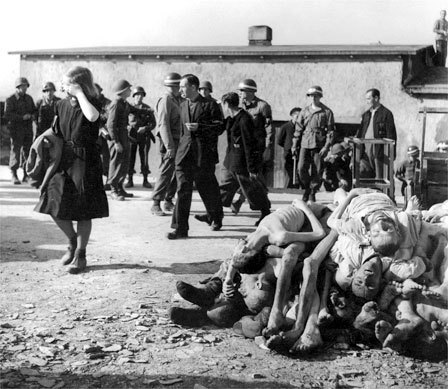 George Patton's troops when they liberated the Buchenwald concentration camp. Forty-three thousand people had been murdered there. Patton was so outraged he ordered his men to march German civilians through the camp so they could see with their own eyes what their nation had wrought.
George Patton's troops when they liberated the Buchenwald concentration camp. Forty-three thousand people had been murdered there. Patton was so outraged he ordered his men to march German civilians through the camp so they could see with their own eyes what their nation had wrought.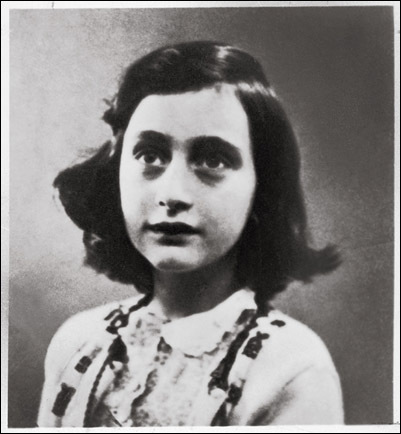 Six million Jews died in the Holocaust. For many throughout the world, one teenage girl gave them a story and a face. She was Anne Frank, the adolescent who, according to her diary, retained her hope and humanity as she hid with her family in an Amsterdam attic. In 1944 the Nazis, acting on a tip, arrested the Franks; Anne and her sister died of typhus at Bergen-Belsen only a month before the camp was liberated. The world came to know her through her words and through this ordinary portrait of a girl of 14. She stares with big eyes, wearing an enigmatic expression, gazing at a future that the viewer knows will never come.
Six million Jews died in the Holocaust. For many throughout the world, one teenage girl gave them a story and a face. She was Anne Frank, the adolescent who, according to her diary, retained her hope and humanity as she hid with her family in an Amsterdam attic. In 1944 the Nazis, acting on a tip, arrested the Franks; Anne and her sister died of typhus at Bergen-Belsen only a month before the camp was liberated. The world came to know her through her words and through this ordinary portrait of a girl of 14. She stares with big eyes, wearing an enigmatic expression, gazing at a future that the viewer knows will never come. or "The Kiss", at the end of World War II, in US cities everybody went to the streets to salute the end of combat. Friendship and unity were everywhere. This picture shows a sailor kissing a young nurse in Times Square. The fact is he was kissing every girl he encountered and for that kiss, this particular nurse slapped him.
or "The Kiss", at the end of World War II, in US cities everybody went to the streets to salute the end of combat. Friendship and unity were everywhere. This picture shows a sailor kissing a young nurse in Times Square. The fact is he was kissing every girl he encountered and for that kiss, this particular nurse slapped him.By Alfred Eisenstaedt
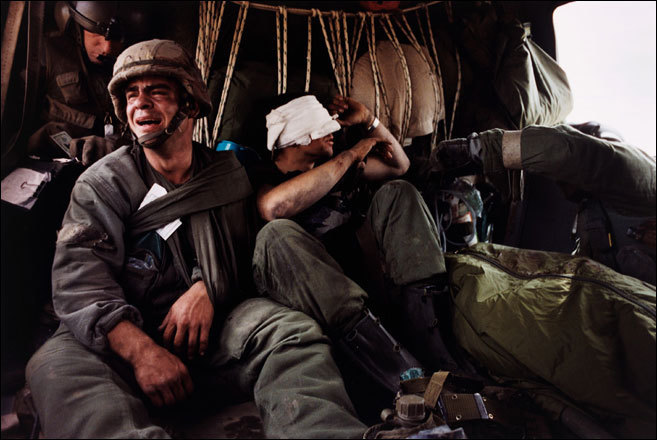 Image of a young US sergeant at the moment he learns that the body bag next to him contains the body of his friend, killed by "friendly fire".
Image of a young US sergeant at the moment he learns that the body bag next to him contains the body of his friend, killed by "friendly fire".The widely published photo became an iconic image of the 1991 Gulf war - a war in which media access was limited by Pentagon restrictions.
By David Turnley
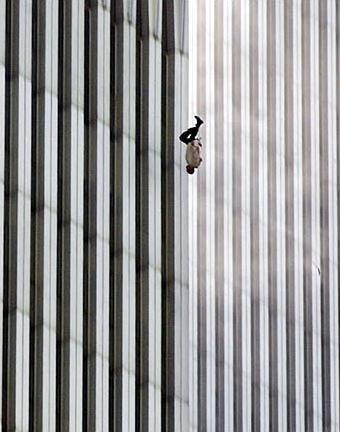 The powerful and controversial photograph provoked feelings of anger, particularly in the United States, in the immediate aftermath of the September 11 attacks. The photo ran only once in many American newspapers because they received critical and angry letters from readers who felt the photo was exploitative, voyeuristic, and disrespectful of the dead. This led to the media's self-censorship of the photograph, preferring instead to print photos of acts of heroism and sacrifice.
The powerful and controversial photograph provoked feelings of anger, particularly in the United States, in the immediate aftermath of the September 11 attacks. The photo ran only once in many American newspapers because they received critical and angry letters from readers who felt the photo was exploitative, voyeuristic, and disrespectful of the dead. This led to the media's self-censorship of the photograph, preferring instead to print photos of acts of heroism and sacrifice.Drew commented about the varying reactions, saying, "This is how it affected people's lives at that time, and I think that is why it's an important picture. I didn't capture this person's death. I captured part of his life. This is what he decided to do, and I think I preserved that."9/11: The Falling Man ends suggesting that this picture was not a matter of the identity behind the man, but how he symbolized the events of 9/11.
 This picture was shot by Eddie Adams who won the Pulitzer prize with it. The picture shows Nguyen Ngoc Loan, South Vietnam's national police chief executing a prisoner who was said to be a Viet Cong captain. Once again the public opinion was turned against the war.
This picture was shot by Eddie Adams who won the Pulitzer prize with it. The picture shows Nguyen Ngoc Loan, South Vietnam's national police chief executing a prisoner who was said to be a Viet Cong captain. Once again the public opinion was turned against the war.By Eddie Adams
 This is a famous picture, taken in 1930, showing the young black men accused of raping a Caucasian woman and killing her boyfriend, hanged by a mob of 10,000 white men. The mob took them by force from the county jail house. Another black man was left behind and ended up being saved from lynching. Even if lynching photos were designed to boost white supremacy, the tortured bodies and grotesquely happy crowds ended up revolting many.
This is a famous picture, taken in 1930, showing the young black men accused of raping a Caucasian woman and killing her boyfriend, hanged by a mob of 10,000 white men. The mob took them by force from the county jail house. Another black man was left behind and ended up being saved from lynching. Even if lynching photos were designed to boost white supremacy, the tortured bodies and grotesquely happy crowds ended up revolting many.By Lawrence Beitler
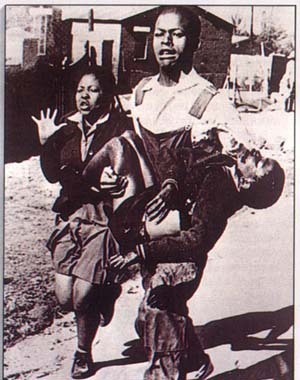 It was a picture that got the world's attention: A frozen moment in time that showed 13-year-old Hector Peterson dying after being struck down by a policeman's bullet.
It was a picture that got the world's attention: A frozen moment in time that showed 13-year-old Hector Peterson dying after being struck down by a policeman's bullet.By Sam Nzima
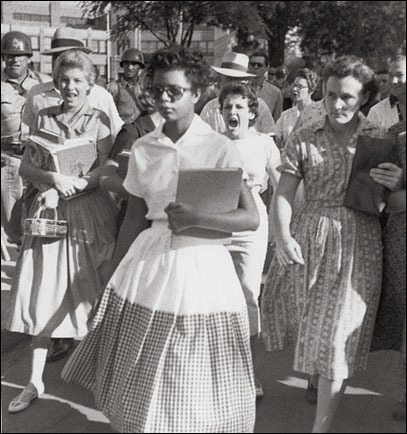 It was the fourth school year since segregation had been outlawed by the Supreme Court. Things were not going well, and some southerners accused the national press of distorting matters. This picture, however, gave irrefutable testimony, as Elizabeth Eckford strides through a gantlet of white students, including Hazel Bryant (mouth open the widest), on her way to Little Rock's Central High.
It was the fourth school year since segregation had been outlawed by the Supreme Court. Things were not going well, and some southerners accused the national press of distorting matters. This picture, however, gave irrefutable testimony, as Elizabeth Eckford strides through a gantlet of white students, including Hazel Bryant (mouth open the widest), on her way to Little Rock's Central High. The Triangle Shirtwaist Company always kept its doors locked to ensure that the young immigrant women stayed stooped over their machines and didn't steal anything. When a fire broke out on Saturday, March 25, 1911, on the eighth floor of the New York City factory, the locks sealed the workers' fate. In just 30 minutes, 146 were killed. Witnesses thought the owners were tossing their best fabric out the windows to save it, then realized workers were jumping, sometimes after sharing a kiss (the scene can be viewed now as an eerie precursor to the World Trade Center events of September, 11, 2001, only a mile and a half south). The Triangle disaster spurred a national crusade for workplace safety.
The Triangle Shirtwaist Company always kept its doors locked to ensure that the young immigrant women stayed stooped over their machines and didn't steal anything. When a fire broke out on Saturday, March 25, 1911, on the eighth floor of the New York City factory, the locks sealed the workers' fate. In just 30 minutes, 146 were killed. Witnesses thought the owners were tossing their best fabric out the windows to save it, then realized workers were jumping, sometimes after sharing a kiss (the scene can be viewed now as an eerie precursor to the World Trade Center events of September, 11, 2001, only a mile and a half south). The Triangle disaster spurred a national crusade for workplace safety.Phan Thi. Kim Phúc [1972]
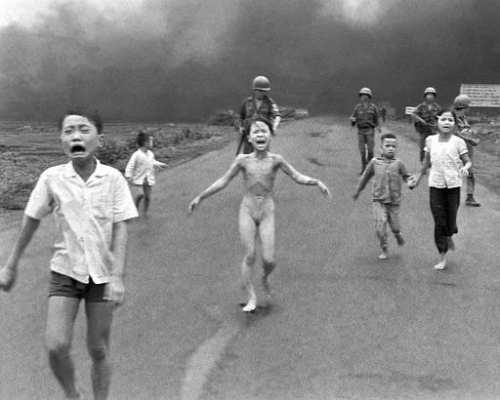 Phan Thi. Kim Phúc known as Kim Phuc (born 1963) was the subject of a famous photo from the Vietnam war. The picture shows her at about age nine running naked after being severely burned on her back by a napalm attack.
Phan Thi. Kim Phúc known as Kim Phuc (born 1963) was the subject of a famous photo from the Vietnam war. The picture shows her at about age nine running naked after being severely burned on her back by a napalm attack.By Huy..nh Công Út
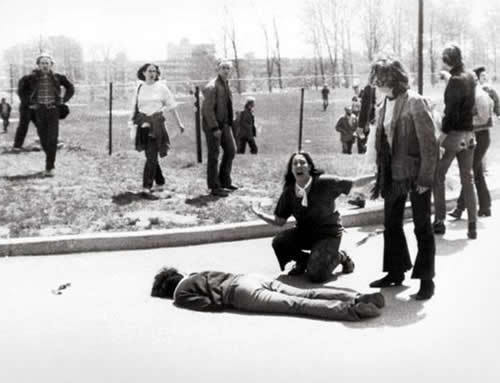 The news that Richard Nixon was sending troops to Cambodia caused a chain of protests in the U.S. colleges. At Kent State the protest seemed more violent, some students even throwing rocks. In consequence, The Ohio National Guard was called to calm things down, but the events got out of hand and they started shooting. Some of the victims were simply walking to school. The photo shows 14-year-old Mary Ann Vecchio kneeling over the body of Jeffrey Miller who had been shot by the Ohio National Guard moments earlier.
The news that Richard Nixon was sending troops to Cambodia caused a chain of protests in the U.S. colleges. At Kent State the protest seemed more violent, some students even throwing rocks. In consequence, The Ohio National Guard was called to calm things down, but the events got out of hand and they started shooting. Some of the victims were simply walking to school. The photo shows 14-year-old Mary Ann Vecchio kneeling over the body of Jeffrey Miller who had been shot by the Ohio National Guard moments earlier.By John Paul Filo
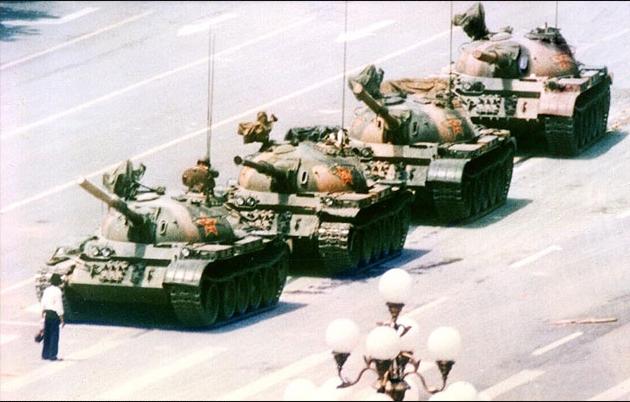 This is the picture of a student/man going to work who has just had enough. The days leading up to this event thousands of protesters and innocent by standers were killed by their own government because the Chinese people wanted more rights. He tries to stop the tanks in Tiananmen Square by standing in front of them and climbed on the tank and hitting the hatch and yelling, the tank driver didn't crush the man with the bags as a group of unknown people came and dragged him away, we still don't know if the man is alive or dead as the Chinese government executed many of the protesters involved. China is still controlled by a communist regime, but while there are strong willed men like this the country still has hope.
This is the picture of a student/man going to work who has just had enough. The days leading up to this event thousands of protesters and innocent by standers were killed by their own government because the Chinese people wanted more rights. He tries to stop the tanks in Tiananmen Square by standing in front of them and climbed on the tank and hitting the hatch and yelling, the tank driver didn't crush the man with the bags as a group of unknown people came and dragged him away, we still don't know if the man is alive or dead as the Chinese government executed many of the protesters involved. China is still controlled by a communist regime, but while there are strong willed men like this the country still has hope.By Jeff Widener
 Thích Qua?ng Ðu+'c was a Vietnamese Buddhist monk who burned himself to death at a busy Saigon intersection on June 11, 1963. His act of self-immolation, which was repeated by others, was witnessed by David Halberstam, a New York Times reporter, who wrote:
Thích Qua?ng Ðu+'c was a Vietnamese Buddhist monk who burned himself to death at a busy Saigon intersection on June 11, 1963. His act of self-immolation, which was repeated by others, was witnessed by David Halberstam, a New York Times reporter, who wrote:" I was to see that sight again, but once was enough. Flames were coming from a human being; his body was slowly withering and shriveling up, his head blackening and charring. In the air was the smell of burning human flesh; human beings burn surprisingly quickly. Behind me I could hear the sobbing of the Vietnamese who were now gathering. I was too shocked to cry, too confused to take notes or ask questions, too bewildered to even think.... As he burned he never moved a muscle, never uttered a sound, his outward composure in sharp contrast to the wailing people around him."
By Arthur Sasse
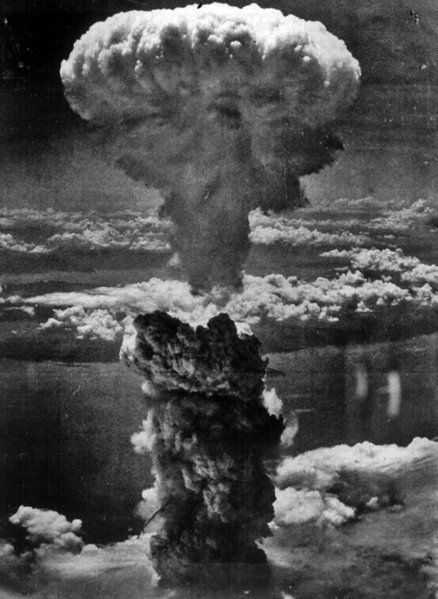 This is the picture of the "mushroom cloud" showing the enormous quantity of energy. The first atomic bomb was released on August 6 in Hiroshima (Japan) and killed about 80,000 people. On August 9 another bomb was released above Nagasaki. The effects of the second bomb were even more devastating - 150,000 people were killed or injured. But the powerful wind, the extremely high temperature and radiation caused enormous long term damage.
This is the picture of the "mushroom cloud" showing the enormous quantity of energy. The first atomic bomb was released on August 6 in Hiroshima (Japan) and killed about 80,000 people. On August 9 another bomb was released above Nagasaki. The effects of the second bomb were even more devastating - 150,000 people were killed or injured. But the powerful wind, the extremely high temperature and radiation caused enormous long term damage.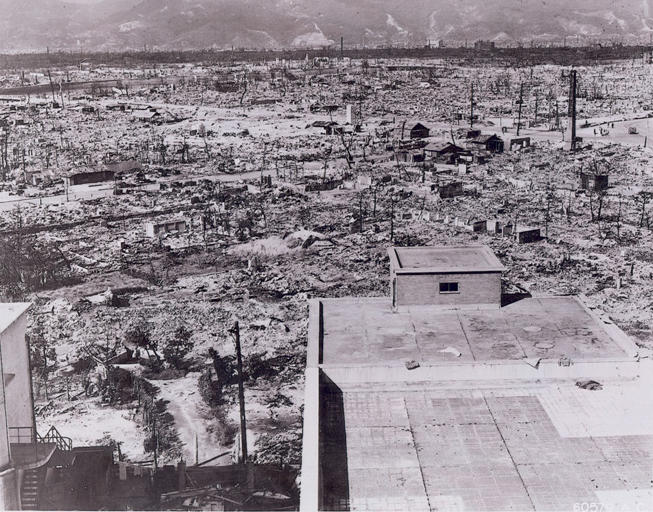 Americans -- and everyone -- had heard of the bomb that "leveled" Hiroshima, but what did that mean? When the aerial photography was published, that question was answered.
Americans -- and everyone -- had heard of the bomb that "leveled" Hiroshima, but what did that mean? When the aerial photography was published, that question was answered.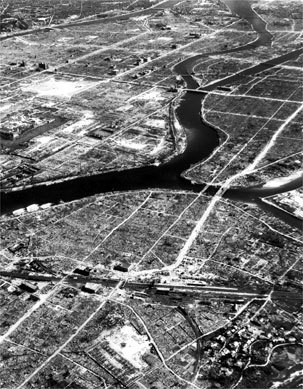 And here is a ground view of the destruction.
And here is a ground view of the destruction.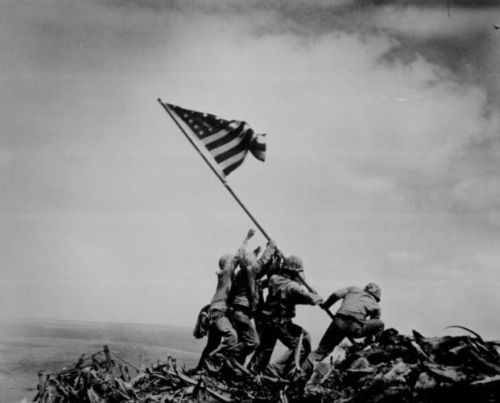 Raising the Flag on Iwo Jima is a historic photograph taken on February 23, 1945, by Joe Rosenthal. It depicts five United States Marines and a U.S. Navy corpsman raising the flag of the United States atop Mount Suribachi during the Battle of Iwo Jima in World War II.
Raising the Flag on Iwo Jima is a historic photograph taken on February 23, 1945, by Joe Rosenthal. It depicts five United States Marines and a U.S. Navy corpsman raising the flag of the United States atop Mount Suribachi during the Battle of Iwo Jima in World War II.The photograph was extremely popular, being reprinted in thousands of publications. Later, it became the only photograph to win the Pulitzer Prize for Photography in the same year as its publication, and ultimately came to be regarded as one of the most significant and recognizable images of the war, and possibly the most reproduced photograph of all times.
By Joe Rosenthal
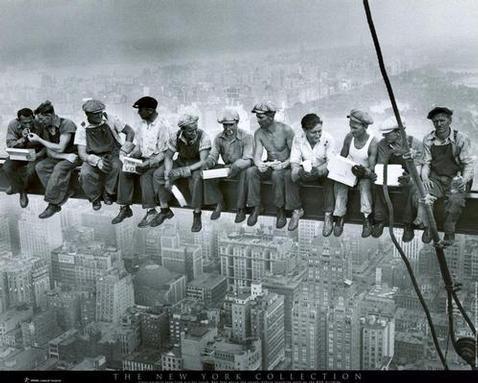 Lunch atop a Skyscraper (New York Construction Workers Lunching on a Crossbeam) is a famous photograph taken by Charles C. Ebbets during construction of the GE Building at Rockefeller Center in 1932.
Lunch atop a Skyscraper (New York Construction Workers Lunching on a Crossbeam) is a famous photograph taken by Charles C. Ebbets during construction of the GE Building at Rockefeller Center in 1932.The photograph depicts 11 men eating lunch, seated on a girder with their feet dangling hundreds of feet above the New York City streets. Ebbets took the photo on September 29, 1932, and it appeared in the New York Herald Tribune in its Sunday photo supplement on October 2. Taken on the 69th floor of the GE Building during the last several months of construction, the photo Resting on a Girder shows the same workers napping on the beam.
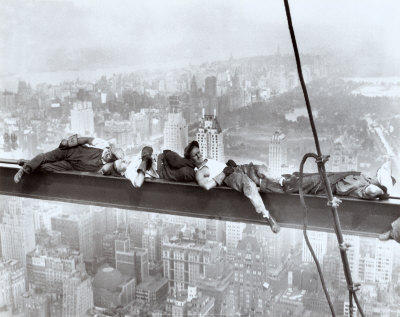 Here's a rare image by the same photographer showing the workers sleeping on the crossbeam.
Here's a rare image by the same photographer showing the workers sleeping on the crossbeam. For many, this picture of Florence Owens Thompson (age 32) represents the Great Depression. She was the mother of 7 and she struggled to survive with her kids catching birds and picking fruits. Dorothea Lange took the picture after Florence sold her tent to buy food for her children. She made the first page of major newspapers all over the country and changed people's conception about migrants.
For many, this picture of Florence Owens Thompson (age 32) represents the Great Depression. She was the mother of 7 and she struggled to survive with her kids catching birds and picking fruits. Dorothea Lange took the picture after Florence sold her tent to buy food for her children. She made the first page of major newspapers all over the country and changed people's conception about migrants.By Dorothea Lange
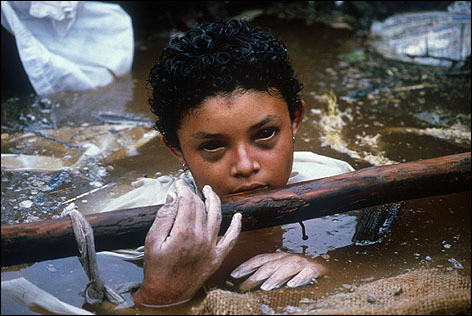 Red Cross rescue workers had apparently repeatedly appealed to the government for a pump to lower the water level and for other help to free the girl. Finally rescuers gave up and spent their remaining time with her, comforting her and praying with her. She died of exposure after about 60 hours. By Frank Fournier
Red Cross rescue workers had apparently repeatedly appealed to the government for a pump to lower the water level and for other help to free the girl. Finally rescuers gave up and spent their remaining time with her, comforting her and praying with her. She died of exposure after about 60 hours. By Frank Fournier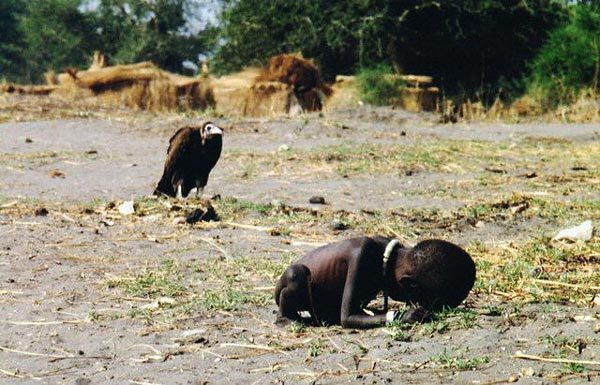 The prize-winning image: A vulture watches a starving child in southern Sudan, March 1, 1993.
The prize-winning image: A vulture watches a starving child in southern Sudan, March 1, 1993.Carter's winning photo shows a heart-breaking scene of a starving child collapsed on the ground, struggling to get to a food center during a famine in the Sudan in 1993. In the background, a vulture stalks the emaciated child.
Carter was part of a group of four fearless photojournalists known as the "Bang Bang Club" who traveled throughout South Africa capturing the atrocities committed during apartheid.
Haunted by the horrific images from Sudan, Carter committed suicide in 1994 soon after receiving the award.
By Kevin Carter
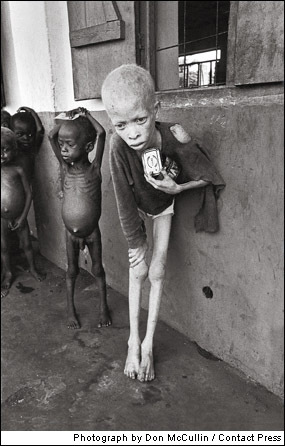 When the Igbos of eastern Nigeria declared themselves independent in 1967, Nigeria blockaded their fledgling country-Biafra. In three years of war, more than one million people died, mainly of hunger. In famine, children who lack protein often get the disease kwashiorkor, which causes their muscles to waste away and their bellies to protrude. War photographer Don McCullin drew attention to the tragedy. "I was devastated by the sight of 900 children living in one camp in utter squalor at the point of death," he said. "I lost all interest in photographing soldiers in action." The world community intervened to help Biafra, and learned key lessons about dealing with massive hunger exacerbated by war-a problem that still defies simple solutions.
When the Igbos of eastern Nigeria declared themselves independent in 1967, Nigeria blockaded their fledgling country-Biafra. In three years of war, more than one million people died, mainly of hunger. In famine, children who lack protein often get the disease kwashiorkor, which causes their muscles to waste away and their bellies to protrude. War photographer Don McCullin drew attention to the tragedy. "I was devastated by the sight of 900 children living in one camp in utter squalor at the point of death," he said. "I lost all interest in photographing soldiers in action." The world community intervened to help Biafra, and learned key lessons about dealing with massive hunger exacerbated by war-a problem that still defies simple solutions.By Don McCullin
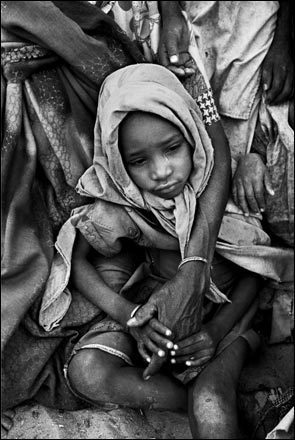 It's an image which depicts a depressed, shoulders-down figure of a child in a cluster of what remains of her family.
It's an image which depicts a depressed, shoulders-down figure of a child in a cluster of what remains of her family.The very weather-beaten arm of her mother goes over her left shoulder and there are the very small weather-beaten hands of the child, who is about five or six, clinging on to this one piece of security that she has, which is the weather-beaten hand of her mother.
The mother is not in the image, she's in the background. But then slightly further in the background you see the other hands of her brothers and sisters as they wait in this village.
By Marcus Bleasdale
 Anyone who knows anything about firefighters know that their gloves are very rough and abrasive and to remove these is like saying I want to make sure that I am as gentle and as compassionate as I can be with this infant that I don't know is dead or alive.
Anyone who knows anything about firefighters know that their gloves are very rough and abrasive and to remove these is like saying I want to make sure that I am as gentle and as compassionate as I can be with this infant that I don't know is dead or alive.The fireman is just cradling this infant with the utmost compassion and caring.
He is looking down at her with this longing, almost to say with his eyes: "It's going to be OK, if there's anything I can do I want to try to help you."
He doesn't know that she has already passed away.
By Chris Porter
How Life Begins [1965]
 In 1957 he began taking pictures with an endoscope, an instrument that can see inside a body cavity, but when Lennart Nilsson presented the rewards of his work to LIFE's editors several years later, they demanded that witnesses confirm that they were seeing what they thought they were seeing. Finally convinced, they published a cover story in 1965 that went on for 16 pages, and it created a sensation. Then, and over the intervening years, Nilsson's painstakingly made pictures informed how humanity feels about . . . well, humanity. They also were appropriated for purposes that Nilsson never intended. Nearly as soon as the 1965 portfolio appeared in LIFE, images from it were enlarged by right-to-life activists and pasted to placards.
In 1957 he began taking pictures with an endoscope, an instrument that can see inside a body cavity, but when Lennart Nilsson presented the rewards of his work to LIFE's editors several years later, they demanded that witnesses confirm that they were seeing what they thought they were seeing. Finally convinced, they published a cover story in 1965 that went on for 16 pages, and it created a sensation. Then, and over the intervening years, Nilsson's painstakingly made pictures informed how humanity feels about . . . well, humanity. They also were appropriated for purposes that Nilsson never intended. Nearly as soon as the 1965 portfolio appeared in LIFE, images from it were enlarged by right-to-life activists and pasted to placards.By Lennart Nilsson

1 comment:
May I also suggest including the scene of a East Berlin Guard jumping the wire when the wall was going up?
Post a Comment